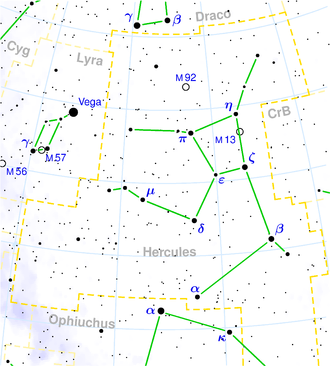NGC 6500
| Galaxy NGC 6500 |
|
|---|---|
![NGC 6500 [1] Hubble Space Telescope](https://upload.wikimedia.org/wikipedia/commons/thumb/4/41/NGC_6500_hst_05924_547.png/300px-NGC_6500_hst_05924_547.png)
|
|
| NGC 6500 Hubble Space Telescope | |
| AladinLite | |
| Constellation | Hercules |
|
Position equinox : J2000.0 , epoch : J2000.0 |
|
| Right ascension | 17 h 55 m 59.7822 s |
| declination | + 18 ° 20 ′ 17.668 ″ |
| Appearance | |
| Morphological type | SAab / LINER |
| Brightness (visual) | 12.2 mag |
| Brightness (B-band) | 13 likes |
| Angular expansion | 2.2 ′ × 1.6 ′ |
| Position angle | 50 ° |
| Surface brightness | 13.4 mag / arcmin² |
| Physical data | |
| Affiliation | isolated NGC 6500 group LGG 414 |
| Redshift | 0.010017 ± 0.000017 |
| Radial velocity | 3003 ± 5 km / s |
|
Stroke distance v rad / H 0 |
(141 ± 10) · 10 6 ly (43.3 ± 3.0) Mpc |
| history | |
| discovery | William Herschel |
| Discovery date | June 29, 1799 |
| Catalog names | |
| NGC 6500 • UGC 11048 • PGC 61123 • CGCG 113-008 • MCG + 03-46-003 • IRAS 17537 + 1820 • 2MASX J17555979 + 1820178 • GC 4348 • H III 957 • NVSS J175559 + 182018 • LDCE 1274 NED005 • KPG 526A | |
NGC 6500 is a spiral galaxy with an active nucleus of the Hubble type Sab in the constellation Hercules in the northern sky . It is an estimated 141 million light years away from the Milky Way and about 90,000 light years in diameter . Together with NGC 6501 , it forms the isolated, gravitationally bound galaxy pair KPG 526 .
It is the brightest member of the six-galaxy NGC 6500 group ( LGG 414 ).
The object was discovered in 1799 by the astronomer William Herschel with the help of his 18.7-inch reflector telescope and was later added to his New General Catalog by Johan Dreyer .
NGC 6500 group ( LGG 414 )
| Galaxy | Alternative name | Distance / million Lj |
|---|---|---|
| NGC 6430 | PGC 60805 | 144 |
| NGC 6467 | PGC 60972 | 143 |
| NGC 6500 | PGC 61123 | 141 |
| NGC 6501 | PGC 61128 | 144 |
| PGC 61102 | UGC 11037 | 147 |
| PGC 61116 | UGC 11044 | 136 |
